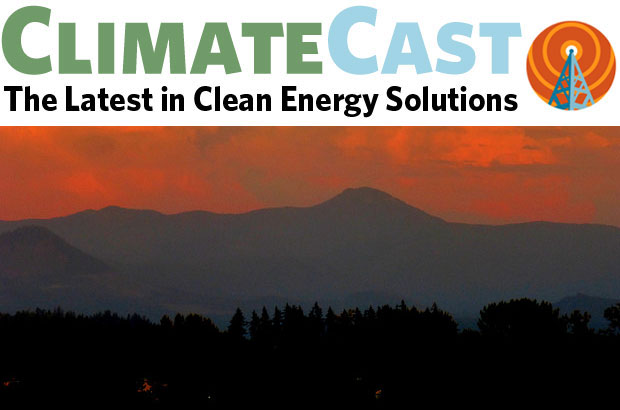Pacific Northwest state legislatures fail to pass bold climate policy
Multiple outlets have reported on the dramatic decline of snowpack in the American West; average snowpack has declined 30 percent on average since one century ago. Another year of low salmon returns is expected due to drought, warmer than normal ocean temperatures, and poor ocean conditions.
Despite these glaring climate impacts, and despite Democratic majorities, neither the Oregon nor the Washington State Legislatures passed bold climate policy in 2018. The Washington Legislature did pass a limited measure to boost oil transport safety. But a bill that would have set the state on a path to achieve 100 percent fossil-free electricity by 2045 was allowed to die on the last day of session. A carbon price proposal backed by Washington State’s Governor also didn’t pass. In Oregon, the Clean Energy Jobs bill to cap and price climate pollution did not pass, but there are reasons for look ahead to 2019 with encouragement: The Senate President stated that “we’re going to do this in ‘19 or don’t bother coming,” and the state legislature invested resources to back up the commitment: they allocated more than $1 million to help the Oregon program stay on track for implementation in 2021, and created a Joint Committee on Carbon Reduction to continue working on the policy and tee it up for passage in 2019
Diverse WA coalition takes next step towards clean energy, clean air ballot measure
A diverse group of constituencies filed a state initiative in Washington that would invest in clean energy and communities to advance solutions to the climate crisis -- and no longer wait for state legislative action. The initiative would impose a fee on industrial emitters and invest the revenue in clean energy, forest health, transportation, communities -- especially those hit hardest by pollution -- and a just transition for workers. The head of the Washington State Labor Council noted the breadth of support, “It’s the broadest and deepest coalition that I’ve ever been involved in in Washington State in the 32 years I’ve been here. It is made up of organizations of color, faith-based groups, environmental groups, tribes, labor, public health, women’s groups – it’s really, really exciting.” Twenty nine tribes with the Affiliated Tribes of Northwest Indians also support the initiative effort.
Renewable Energy Goes Up as Fracked Gas Plants Close Down
California just set a new solar power record for all-time peak percentage of demand, hitting 49.95 percent. As renewables ramp up in California, fracked gas plants in the state are closing down. The reason? Community opposition and the growth of clean energy in the state. In other solar news, tech giant Microsoft has announced plans to purchase rooftop solar across Singapore to power its data centers. There have also been major developments in US renewable power storage; new research shows that the aggregate energy storage capacity in the US had grown to 431 megawatt hours by last year, and is expected to more than double, to an anticipated 1233 megawatt hours, in 2018.
The world’s first-ever floating offshore windfarm achieved a record 65 percent capacity factor this winter, a significant milestone considering that the typical capacity factor for offshore wind is 45-60 percent. Wind power could become even more prevalent soon, as the world’s most powerful wind turbine nears completion. It will begin operating in 2021, and has 45 percent more capacity than the standard wind turbines of today.
Climate chaos: extreme storms, early arctic spring, and severe drought on the horizon
As we write this, the east coast is gearing up for another Nor’easter to hit this week. While these storms are a regular winter occurrence on the east coast, their strength and ferocity are increasing due to climate change. In fact, they’re now considered to be just as dangerous as hurricanes. To make matters worse, new research shows that FEMA has dramatically underestimated how vulnerable Americans are to flooding; the population of Americans exposed to serious flooding risk is 2.6–3.1 times higher than previous estimates. In other impact news, Arctic spring started 16 days early this year, in one of the global regions where a changing climate can be most easily observed. Temperatures there are rising twice as fast as the global average. Farmers are already worrying about predictions for widespread drought this summer. Early indicators suggest that this year’s drought could parallel the situation in 2012 when the US experienced its worst drought since the Dust Bowl. As such droughts become more frequent, new research finds that rising temperatures could decrease some California crop yields by as much as 40 percent by 2050 -- a big deal when you consider that California grows about two-thirds of the nation's produce.
The need for climate justice as highlighted by teachers, kids, and communities of color
The West Virginia teachers’ strike is over, and additional funds for teachers will most likely come from a cut to general services. But teachers had urged the state’s fossil fuel industry to chip in instead, arguing they should pay their fair share for the negative impact their pollution has on West Virginia communities. A 5 to 7.5 percent tax on coal and gas would have been enough to cover needed revenue. One fifth grade teacher summed up the issue by saying, “Our state is in poverty and will continue to be in poverty because these industries come in and tell our representatives how things are going to go.” In other action, youth fighting for climate justice through the courts just got a big boost; a federal appeals court rejected the Trump administration’s attempt to dismiss the kids’ lawsuit.
A proposed fracked gas pipeline project in Oregon that would put the Klamath River at risk of contamination, trample the Klamath Tribes’ territory, and become the largest source of climate pollution in the state is receiving national attention. The project was voted down twice by a local regulatory commission, but the company behind the pipeline project is applying for a permit once again. And a new report concludes that Black Americans are subject to higher levels of damaging air pollution than whites, regardless of wealth. Robert Bullard, a professor of urban planning and environmental policy known as the “father of environmental justice,” said that the study “confirms that race, not poverty, is the strongest predictor of exposure to health-threatening particulate matter.”
In brief: Cities emit more carbon than previously thought
The carbon footprint of some of the world’s biggest cities is 60 percent larger than previously estimated, according to a new analysis. When we factor in all products and services consumed by a city’s residents, its carbon footprint is much larger than it would be otherwise. This means taking into consideration the food, clothing, electronics, air travel, construction materials, and any other goods consumed by local residents but produced outside of city limits.




